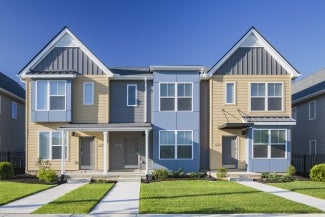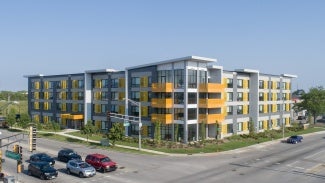
Making homes attainable: How architects can help
The U.S. has long had a shortage of affordable housing. How can architects help in the collective effort to make housing attainable to more people?
The U.S. has long had a shortage of affordable housing. In no state or city can a full-time worker earning minimum wage afford a standard two-bedroom rental unit, according to the National Low Income Housing Coalition. Tens of millions of households are cost-burdened, spending more than one-third of their income on their rent or mortgage, according to the Joint Center for Housing Studies of Harvard University. An analysis by Zillow and StreetEasy found that rents rose 30.4% between 2019 and 2023 while wage growth stalled at 20.2%.
Many architecture firms are active participants and advocates in the affordable housing market because it hits home for everyone. “Housing gives us balance, safety, stability, and communal social bonding,” says Yanitza Brongers-Marrero, FAIA, partner and housing practice leader at Moody Nolan, winner of AIA’s 2021 Firm Award. “Having a home gives humans dignity.”
Restoring one’s dignity, says David Block, director of development at Evergreen Real Estate Group, is the most effective way to address homelessness and help those who have encountered hardships few others can imagine. And the impact extends beyond a household. A Community Preventive Services Task Force study found that programs that address homelessness generate $1.44 in societal cost savings for every $1 invested. Here's how architects can help in the collective effort to make housing more attainable to more people.
Economics of affordability
In the U.S., about 90% of all constructed affordable housing is funded by low-income housing tax credits (LIHTC), a federal subsidy primarily comprising two dollar-for-dollar tax credits.
The first one of these two, the 4% credit, is a noncompetitive federal award that provides credits over a 10-year period that roughly equates to 30% of a project’s qualified basis.
The second, a 9% credit, is awarded through a competitive process by a state’s housing finance agency and draws from the federal subsidy allocated to each state. It roughly equates to covering 70% of a project’s qualified basis, which makes it an attractive incentive to developers and investors. For a project to qualify for LIHTC financing, at least 20% of its units must be attainable by residents earning 50% or less of the area median income (AMI), or at least 40% of its units are attainable by residents making 60% of AMI. Rents must be kept affordable for a minimum compliance period of 15 years plus an extended use period of an additional 15 years.
Constructing affordable housing costs about the same as constructing market-rate housing, Brongers-Marrero notes, though some savings may be found in finish selections and reduced amenities. Consequently, without LIHTC, owners would recoup their investment significantly slower, if at all.
But developers might have other reasons for pursuing these projects, says David Kennedy, AIA, mixed-use design leader at Bailey Edward. Increasing housing access might be enough to motivate nonprofit developers. Through LIHTC and other state and local grants and bonds, developers might not have to commit or risk much of their own money for a project. They might also offer property management services to help their bottom line.
And affordable housing is almost always 100% leased. Kennedy recalls attending a ribbon-cutting ceremony for a development 60 days after its completion and learning that the last available lease was signed that day.

How can architects help developers?
Architects can be invaluable partners to developers by helping ensure a project’s qualification for financing. Each state has its own Qualified Allocation Plan (QAP), which details eligibility criteria such as programming information, proximity to neighborhood amenities, and compliance with green building certification programs, like Enterprise Green Communities.
Though quality of space and design were not historically prioritized in affordable housing, attitudes have changed, says Block, who practiced architecture before entering development in the early 2000s. The building profession, investors, and cities “have recognized there is value in having well-designed affordable housing,” he says. “We’re all working, in some ways, in the shadow of the mistakes made in the 1940s and ’50s when there was not a design focus, but rather a warehousing of people.”
Failed public housing projects from the mid-20th century, such as Pruitt-Igoe in St. Louis and Cabrini-Green in Chicago, packed residents in dense high-rises that were physically and visually isolated from surrounding neighborhoods and amenities, such as green spaces. Poor construction quality also accelerated the need for maintenance and repair, for which budget was lacking. The rapid deterioration led to dangerous and unsanitary conditions while an overall disregard to give residents a sense of ownership and community ultimately doomed these developments.
Today, the paperwork and scoring systems to receive the go-ahead for affordable housing communities are intensive, and Kennedy half-jokingly recommends having a dictionary of acronyms at the ready. But for architects who have gained fluency in QAPs, their input can make the difference between a project’s approval and rejection. Christopher Coates, AIA, a project architect and housing design leader at HED, recently reviewed a proposed Indiana development’s QAP to optimize on scoring opportunities and identified five additional points because of his design and programming expertise. “That was a successful meeting, to go through the QAP,” he says.
Moody Nolan works on a gamut of affordable housing developments, from large-scale multifamily communities to its Legacy Project, a commitment by founder Curtis Moody, FAIA, to design and deliver a house to a family in need in each of his firm’s 12 locations. But to effect greater change, architects need to scale the design of projects that satisfy QAPs and developer pro formas. “We can create efficiencies in the way we design that help reduce costs and are easy to replicate,” Brongers-Marrero says.
For example, designers can configure layouts to fit more units, ultimately housing more people and generating more rental income. To “convince somebody that living in a smaller unit is a good thing,” Brongers-Marrero says, architects can provide more communal amenities and show successful housing models in other countries.
Likewise, Kennedy hopes to increase project efficiency and sustainability through innovations such as prefabrication and modular construction, as well as timber construction.
In San Diego, which offers a density bonus for developments providing “micro-units” averaging no more than 600 square feet, Coates is experimenting with mixing modular and micro-units to serve more families and attract investor interest. Moreover, he hopes the higher densities can help supply “missing middle” housing, projects with mixed densities that don’t necessarily qualify for subsidies.

Advocacy and architects
The focus on budgets and building densities might seem to overshadow the people in need of housing, but the reality is that no shovels will hit the ground until builders secure financing and projects secure approval from their local jurisdiction. Herein lies another opportunity for architects: advocacy.
Multifamily developments may require rezoning or a variance from the local zoning board, which necessitates public hearings. At these meetings, Brongers-Marrero has encountered “a lot of bias toward housing and not-in-my-backyard (NIMBY) attitudes,” she says. “For us to overcome those hurdles, we need to paint the picture that more density on a site is going to be an asset for the community.”
The nonprofit organization Bipartisan Policy Center identified restrictive land-use and zoning policies as a “major barrier to increasing our nation’s housing supply in high-demand regions.” Kennedy and Coates have also encountered neighboring residents who believe affordable housing developments will “destroy their property values and change their communities,” Kennedy says. “We have to fight against that because it’s absolutely not true. There’s no data that shows that it’s true.”
Coates cites a 2023 Cityscape article, published by HUD’s Office of Policy Development and Research, which found that “the average LIHTC property contributes to a meaningful increase in surrounding property values,” regardless of project-specific and neighborhood-level factors, such as the number and mix of subsidized to market-rate dwelling units and income levels in the surrounding area. “At the very ‘worst,’ it’s a neutral spillover effect,” Coates summarized.
Another challenge is the cap on tax credits offered by the federal government. “The cost of construction has increased dramatically since the beginning of COVID, in some cases even doubling over the last four years,” Block says. “And the resources have not kept up with the increasing cost of these projects.”
This year, states received the greater of $2.90 multiplied by their population or the small-state minimum of $3.36 million in housing credits. The Biden administration had proposed an increase in per-capita allocation to $4.25 from last year’s amount of $2.75, but it did not pass the U.S. House of Representatives.
Some state and local governments are helping to cover shortfalls with grants and other funding vehicles, but Kennedy says the time-consuming nature of affordable housing developments combined with the competition for a small pool of resources have deterred some developers from entering the sector.
As part of her advocacy work with AIA Ohio and at AIA Grassroots, Brongers-Marrero has helped elevate the importance of housing with national and state representatives. She and other members prepare themselves to “have conversations with people that may not understand the architectural lexicon so we can move forward and get more buy-in,” she says.
Entering the market
Code-switching is essential for any architect interested in real estate development, Block says. “As an architect, you are trained in speaking the language of design,” he says. However, developers must be ready to address the concerns of a bank, insurance company, or community development organization, such as project risk or environmental issues that might drive up timelines and cost.
Block also recommends networking. “The affordable housing community is generous in giving its time,” he says. “There is advice for anybody who asks for it.” Kennedy suggests nonprofit organizations, such as the Illinois Housing Council, as great places to learn from advocates, members, and lenders in the AEC economy.
And though the affordable housing sector does face tight budgets, its groundswell of demand can provide a reliable source of work for design firms when the private sector slows—though it won’t likely be the most profitable market for firms with footholds in multiple areas, Kennedy acknowledges. The work is “more of a passion because housing is a personal thing, right?” he says. “We all know it and we all understand it.”
Coates also values the mission and opportunities made possible when housing is attainable. The thought of families moving into the two- and three-bedroom units in the communities he designs, and their children progressing through the local school system to graduation, inspires him. “The buildings and developments that we put forth are being lived in by individuals that will reshape or help the community,” he says. “And that is enough to keep me going at least.”
Wanda Lau is a freelance writer from Chicago, Ill., covering the built environment.


